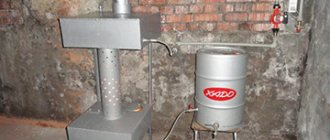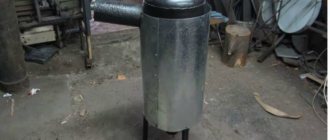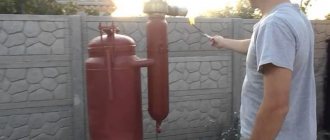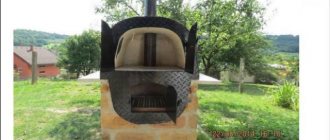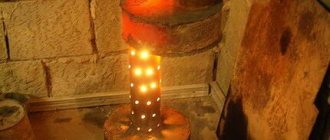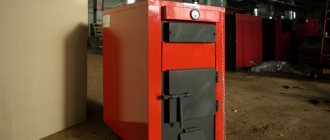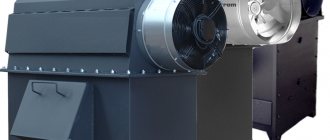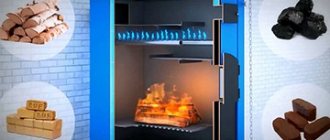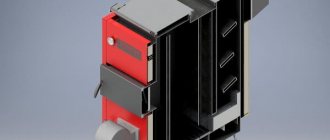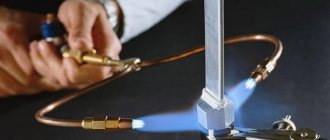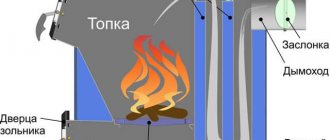They say that all new products are well forgotten old ones. The creation of heating systems based on pyrolysis combustion is no exception. The first plants using pyrolysis technology were built back in the 70s of the 19th century.
Homemade pyrolysis boiler
This technology is still widely used both here and abroad for oil refining. Actually, “pyrolysis” is the process of chemical decomposition of organic matter under the influence of high temperature. In devices using solid organic fuel (usually firewood), the solid part and the gases released from it during thermal decomposition burn separately, which significantly increases the efficiency of such boilers.
Despite the complex name and sophisticated description of the process, you can easily build a pyrolysis boiler with your own hands; for this you will need sheet steel, a welding machine and drawings, which you can take from our website.
The operating principle of pyrolysis boilers and their features
By creating pyrolysis boilers with their own hands, people strive to save money in their wallet.
If gas equipment is quite cheap, then solid fuel units are simply amazing in their price. A more or less decent model with a power of 10 kW will cost 50-60 thousand rubles - it would be cheaper to install gas if there was a gas main nearby. But if it is not there, then there are two options - purchase factory equipment or make it yourself. It is possible to make a long-burning pyrolysis boiler with your own hands, but it is difficult. Let's first figure out why pyrolysis is needed in general. In conventional boilers and stoves, wood is burned in the traditional way - at high temperatures, with the release of combustion products into the atmosphere. The temperature in the combustion chamber is about +800-1100 degrees, and in the chimney - up to +150-200 degrees. Thus, a significant part of the heat simply flies out.
Direct combustion of wood is used in many heating units:
Solid fuel pyrolysis boilers can use several types of fuel, including waste from wood processing and agricultural processing.
- Solid fuel boilers;
- Stoves-fireplaces;
- Fireplaces with water circuits.
The main advantage of this technique is that it is simple - it is enough to create a combustion chamber and organize the removal of combustion products outside the equipment. The only regulator here is the blower door - by adjusting the clearance, we can adjust the intensity of combustion, thereby influencing the temperature.
In a pyrolysis boiler, assembled with your own hands or purchased in a store, the process of fuel combustion proceeds somewhat differently. Firewood here burns at a low temperature. We can say that this is not even combustion, but slow smoldering. In this case, the wood turns into a kind of coke, simultaneously releasing flammable pyrolysis gases. These gases are sent to the afterburning chamber, where they burn, releasing a large amount of heat.
If you think that this reaction will not give much effect, then you are deeply mistaken - if you look into the afterburner chamber, you will see a roaring flame of a bright yellow, almost white color. The combustion temperature is slightly above +1000 degrees, and more heat is released in this process than during standard wood combustion.
In order for a self-assembled pyrolysis boiler to show maximum efficiency, firewood with a low moisture content is needed. Wet wood will prevent the equipment from reaching full capacity.
The pyrolysis reaction is familiar to us from our school physics course. In the textbook (and maybe in the laboratory office), many of us saw an interesting reaction - wood was placed in a sealed glass flask with a tube, after which the flask was heated over a burner. After a few minutes, the wood began to darken, and pyrolysis products began to come out of the tube - these are flammable gases that could be set on fire and observe a yellow-orange flame.
A do-it-yourself pyrolysis boiler works in a similar way:
Pyrolysis boilers operate for about 4-6 hours on one load of fuel. So it’s worth taking care of a large and steadily replenished supply of firewood in advance.
- Firewood is lit in the firebox until a stable flame appears;
- After this, the access to oxygen is blocked, the flame goes out almost completely;
- The blower fan starts and a high-temperature flame appears in the afterburning chamber.
The design of a pyrolysis boiler is quite simple. The main elements here are: a combustion chamber in which firewood is stored, and an afterburning chamber in which pyrolysis products are burned. Heat is transferred to the heating system through a heat exchanger
In the pyrolysis boiler design, special attention is paid to it
The thing is that the heat exchangers in pyrolysis boilers, assembled with your own hands, are arranged differently from those in gas equipment. Combustion products with air pass here through many metal pipes washed with water. To increase efficiency, boiler water washes not only the heat exchanger itself, but also all other components - a kind of water jacket is created here, which removes excess heat from the hot elements of the boiler unit.
Detailed analysis of the scheme
According to the diagram presented above, our DIY pyrolysis boiler will consist of the following parts:
Apart from the fan, such a controller is the only electronic thing in the entire unit. It is strictly not recommended to save on it.
- Electronic controller that controls the fan for the boiler;
- Door for loading firewood (you can make it yourself or buy a ready-made one);
- Ash pan door;
- Blower fan (purchased in a store, creates draft and draws pyrolysis products into the afterburning chamber).
The controls include the controller itself and handles for opening/closing doors.
Creating a pyrolysis boiler
Analysis of diagrams and drawings
To create a pyrolysis boiler with your own hands, it is important to carefully study the diagrams and drawings. It is from them that you will be able to select a design and determine as accurately as possible the amount of materials needed for construction. The diagram and drawing of the pyrolysis boiler show the main elements, without which it is impossible to build the structure with your own hands:
The diagram and drawing of the pyrolysis boiler show the main elements, without which it is impossible to build the structure with your own hands:
- regulators,
- smoke channels,
- air holes,
- water supply pipes,
- water drainage pipes,
- the combustion chamber,
- fan.
When making a pyrolysis boiler with your own hands, it is very important to adhere to the drawings and diagrams. The fact is that this is a complex device in which high-temperature processes will occur. Therefore, the slightest mistake can turn into an emergency
Therefore, the slightest mistake can turn into an emergency.
For a private home, a pyrolysis boiler with a power of 40 kW will be sufficient. Don't strive for high power. The fact is that in this case the design becomes much more complicated. Not only that, but the final cost also increases.
The choice of power of the pyrolysis boiler you are going to create affects the size of the key parts in the drawing or diagram. The normal functioning of the device depends on the correct selection of sizes.
Advice. If you are the owner of a small house, then you can opt for a boiler with a power of 30 kW. This will be more than enough.
Tools needed to make a boiler yourself
To make a structure with your own hands that works on the basis of a pyrolysis reaction according to drawings and diagrams, you need to stock up on some equipment. To bring your idea to life, you will need the following materials and tools:
- Bulgarian,
- welding machine,
- grinding wheels,
- electric drill,
- electrodes,
- pipes of various diameters,
- steel strips,
- temperature sensor,
- fan,
- metal sheets.
This is a basic set that is necessary to create a pyrolysis system with your own hands according to diagrams and drawings. Of course, during the work process, the need for additional tools and materials may arise.
Attention. The thickness of the steel for the body should be 3 mm, or better yet 4
Subtleties of assembly
Once you select the appropriate scheme, you can begin assembly. In this case, you must adhere to the following recommendations:
The hole through which firewood and briquettes will enter the firebox should be located slightly higher than with conventional solid fuel structures. Don't forget about the limiter. Its main task is to control the amount of air. To create it, you need a seventy-millimeter pipe in cross-section. Its length should be longer than the body. A disk is welded to the limiter. The element must be made of steel. The welding location is the bottom of the structure. As a result, you will have a gap of 40 mm. To make installation of the limiter possible, it is necessary to make holes in the appropriate places on the cover. The best shape for the hole through which firewood will be loaded is a rectangle.
It is important not to forget about the door. It should have a special pad for better fixation
It is also necessary to provide a hole in the design through which ash will be removed. The coolant pipe must be made with a bend
This will increase heat transfer.
Another important element according to any diagram and drawing is the valve. With its help, you can control the amount of coolant entering inside. Therefore, it is best to place it in a convenient and easily accessible place. You can see the algorithm for creating a pyrolysis boiler with your own hands according to the drawings in the video below.
After assembly, the first launch is of great importance. Only after you make sure that there is no carbon monoxide in the combustion products can you say that everything was done correctly. For this it is better to use special equipment.
You can create a boiler that works based on the principle of pyrolysis with your own hands. But before you start, you need to write a project. The main role in it will be played by a drawing with a diagram of the product and dimensions.
Discuss the article on the forum
Manufacturing nuances
From the above, it becomes clear that many complex chemical processes will take place inside the future home-made boiler, and the efficiency and safety of the unit will depend on how correctly they are carried out. Therefore, if a choice has been made in favor of developing the circuit and assembling a home-made unit, this process must be taken with great responsibility.
The situation is complicated by the fact that open sources do not have many drawings, as well as detailed photos of boiler designs. Most of them are generic and lack step-by-step instructions as well as details.
There are two options to solve this situation:
- Buy drawings with step-by-step assembly instructions from manufacturers or people who have good experience in the design, manufacture and testing of gas-generating boilers.
- Take up books and modeling programs yourself to develop a design and drawings for a pyrolysis boiler.
When designing, working out step-by-step instructions, as well as manufacturing, you need to take into account the following features:
- The material from which the gasification, combustion and post-combustion chambers will be made must be steel with a heat-resistant lining. The reason for this is 1000 °C inside the combustion chamber. If you use standard sheet steel, it will burn out in two or three seasons. According to many videos, it most often burns out under the combustion and afterburning chambers.
- It is better to make a water heat exchanger. Although it is more complex because it requires the manufacture of two containers that are connected by a system of pipes, it is more reliable and lasts longer. As for the fire tube heat exchanger, it lasts less, because the pipes must be heated to a temperature of more than 600 ° C. Such heating leads to rapid burnout. People choose such heat exchangers because they are easier to manufacture, because they represent one water container with a small number of vertical tubes placed inside it.
- The heat exchanger is placed only in the rear chamber. It should not be placed in chambers where fuel burns. This is because it will absorb heat, which will disrupt the processes of pyrolysis and combustion of gases. The efficiency will become less.
- Cameras should be made round or rounded. If the design of the pyrolysis boiler includes rectangular containers, then the efficiency will be lower, because that part of the heat that disperses to the corners will simply disappear without giving any benefit. Moreover, such a leak will reduce the temperature in all chambers and disrupt the processes that occur in them. The ideal cameras are round. They look like a barrel placed on its side.
- The nozzles also need to be made round. Ideally, they should be in the shape of a circle. However, such holes quickly become contaminated with ash and need to be cleaned. The latter process damages the lining. Therefore, it is worth choosing a nozzle with a slit that runs through the entire length of the bottom. Due to this solution, the efficiency does not drop very much - up to 3%.
Features of operation of gas generator boilers
The operating efficiency of a pyrolysis boiler largely depends on the type and quality of fuel. Technically, not only wood, but also coal and even peat can be loaded into the firebox; most modern boiler models are designed to use several types of fuel.
Wood burns in about 5-6 hours, depending on the type. The harder the wood, the longer it burns.
Modern models of pyrolysis combustion boilers can operate on various types of wood fuel: firewood, briquettes, pellets, coal, peat, etc.
It will take about ten hours to burn black coal, and the same amount of brown coal will smolder for eight hours. In practice, pyrolysis technology demonstrates the highest heat transfer when loaded with dry wood. Firewood with a moisture content of no more than 20% and a length of about 45-65 cm is considered optimal.
If access to such fuel is not available, you can use coal or other organic fuel: special sawdust briquettes and wood pellets, waste obtained from wood processing, peat, materials with cellulose, etc.
Before starting to operate the boiler, you should carefully study the device manufacturer’s recommendations regarding fuel.
In pyrolysis combustion boilers, the air supply is regulated by conventional mechanical valves. The absence of complex electronics ensures high fault tolerance of the device
Too wet fuel in such devices is unacceptable. When it burns in the firebox, additional water vapor is formed, which contributes to the formation of by-products such as tar and soot.
The walls of the boiler become dirty, heat transfer decreases, and over time the boiler may even stop working and go out.
If you use wood with too high a humidity for a pyrolysis combustion boiler, conditions will arise inside the device for the formation of tar, which will worsen the heat transfer of the device and can lead to breakdowns
If dry fuel is placed in the firebox and the boiler is configured correctly, the pyrolysis gas produced as a result of the operation of the device will produce a yellow-white flame. Such combustion is accompanied by an insignificant release of by-products of fuel combustion.
If the color of the flame is different, it makes sense to check the quality of the fuel, as well as the settings of the device.
Pyrolysis gases mixed with air burn with an even yellow-white flame. If the color of the flame has changed, you may need to check the boiler settings or fuel quality
Unlike conventional solid fuel devices, before loading firewood into pyrolysis boilers running on solid fuel, the firebox must be preheated.
To do this, perform the following steps:
- Load small dry kindling (paper, wood chips, etc.) onto the bottom of the firebox.
- They set it on fire using a torch made of similar materials.
- Close the combustion chamber door.
- The loading chamber door is left slightly open.
- Add portions of kindling as it burns.
- The process is repeated until a layer of smoldering coals forms at the bottom.
By this moment, the firebox has already warmed up to approximately 500-800°C, creating conditions for loading the main fuel. Do not use gasoline, kerosene or any other similar liquid substances to light the kindling. Before warming up the furnace of a long-burning boiler, you should make sure that the device is ready for use.
A characteristic feature of pyrolysis combustion boilers is a small amount of ash and ash, which facilitates the process of cleaning the device and its maintenance
To do this, check the presence of draft, the tightness of the doors, the serviceability of locking mechanisms and control equipment, the presence of coolant in the heating system, etc.
Then you should turn on the thermostat to make sure that voltage is supplied to the device. After this, open the direct draft damper and ventilate the boiler for 5-10 minutes.
What fuel to use
For economical and efficient operation of the pyrolysis boiler, you can use any solid fuel: firewood, coal, peat, pellets, and other combustible materials. The main condition necessary to maintain the pyrolysis combustion process is low humidity, no more than 20%. Wetter fuel must be specially dried to the required level. The ability to use waste from wood, clothing, oil mills and other types of production makes this oven even more profitable to use. The wood content must be at least 70%.
To operate a pyrolysis boiler, it is recommended to choose solid fuel
In conventional stoves, firewood needs to be added every two to three hours. Approximately 10 cubic meters of firewood are consumed in the winter. In pyrolysis boilers, wood burning lasts 12 hours, saving up to 40% over the winter. Coal burns much longer, up to five days, which saves not only fuel, but also time. There are models that are equipped with automatic feeding of fuel pellets, that is, they work in autonomous mode for a long time.
Efficiency
How effective the pyrolysis boiler circuit will be, as well as its operating time, will depend on many factors:
- Fuel type and humidity.
- Thermal insulation of the building.
- Room temperature.
- Outside air temperature.
- Accuracy of design work regarding the heating system.
Naturally, unlike conventional boilers, gas generating equipment is much more efficient. Since when burning wood it is impossible to obtain such high temperature indicators as during the combustion of wood gas obtained from it. The gas combustion process uses less air. In this regard, the burning time and temperature increase. It should also be noted that controlling the combustion process of pyrolysis gas is much simpler.
Equipment installation
The next step is to install the equipment in its original location. Remember that a pyrolysis boiler assembled with your own hands has a hellish weight - don’t even try to move it yourself. Take 3-4 people as assistants and drag the cooled unit into the room allocated for the boiler room. Next we carry out the following work:
- We take the chimney outside and connect it to the pyrolysis boiler;
- We connect the heating system to the boiler;
- We install a security group and check the tightness of the system;
- We install an electrical outlet into the room;
- We install boiler automation and connect a blower fan to it.
Now you can start testing the system - this is done by analogy with the above instructions. Setting up a pyrolysis boiler comes down to setting the optimal coolant temperature. Detailed information on this issue can be found in the instructions for the control controller you are using.
Lining with fireclay bricks allows you to maintain the required temperature conditions and protects the metal.
The controller works as follows: using a temperature sensor, it controls the temperature of the coolant at the outlet of the pyrolysis boiler. As soon as the temperature reaches the set level, the electronics will stop the fan. The combustion of flammable gases will slow down and almost completely stop - the firewood will not go out, it will simply smolder slowly. As soon as the temperature in the circuit drops, the fan will turn on and combustion in the pyrolysis chamber will resume.
Operating principle of a long-burning boiler
In conventional solid fuel units, one fill is enough for 6-7 hours of combustion. Accordingly, if the next portion of resources is not added to the firebox, the temperature in the room will immediately begin to decrease. This occurs due to the fact that the main heat circulates throughout the room according to the principle of free gas movement. Heated by the flame, the air rises and goes out.
The thermal resource of a long-burning boiler is enough for about 1-2 days from one load of firewood. Some models can maintain heat for up to 7 days.
How is such economy and efficiency achieved?
Boiler operation diagram
A long-burning TT boiler differs from a conventional boiler by the presence of two combustion chambers at once. In the first, the fuel itself is burned as standard, and in the second, the gases released during this process are burned.
A major role in this process is played by the timely supply of oxygen, which is provided by the fan.
This principle was implemented relatively recently. In 2000, the Lithuanian company Stropuva first presented this technology, which immediately gained respect and popularity.
Homemade long-burning boiler
Today this is the cheapest and most practical way to heat a country house, where gasification is not provided and there are power outages.
Such units operate on the principle of burning top fuel. As a standard, in all stoves the firebox is located at the bottom, which allows you to take cold air from the floor, heat it and raise it up.
The operating principle of this boiler is somewhat similar to a pyrolysis boiler. The main heat here is released not from the combustion of solid fuel, but from the gases released as a result of this process.
The combustion process itself takes place in a closed space. Through a telescopic pipe, the released gas enters the second chamber, where it is completely burned and mixed with cold air, which is pumped up by a fan.
TT long burning boiler (diagram)
This is a continuous process that continues until the fuel is completely burned out. The temperature during such combustion is very high - about 1200 degrees.
As mentioned above, this boiler has two chambers: a large main one and a small one. The fuel itself is placed in the large chamber. Its volume can reach 500 cubic dm.
The combustion resource can be any solid fuel: sawdust, coal, firewood, pallets.
A constant flow of air is provided by the built-in fan. The advantage of this method is that solid fuel is consumed extremely slowly.
This significantly increases the efficiency of such a heating device. Why does wood burn out so slowly compared to a standard stove?
The bottom line is that only the top layer burns out, since the air is pumped by a fan from above. Moreover, the fan adds air only after the top layer has completely burned out.
There are many models on the market today that work on the same principle, but, depending on the dimensions, material, additional options, they have different efficiency and cost-effectiveness.
Fuel versatility
Universal TT boilers operate on absolutely any fuel, which will greatly simplify their operation for owners. A more budget-friendly option is a long-burning wood-burning TT boiler. It runs exclusively on wood and no other fuel option can be used in it.
Functionality check
The flame temperature in the combustion chamber of pyrolysis gases is about 1,000 degrees.
Do not rush to install the pyrolysis boiler you assembled yourself in its regular place - you need to test it. To do this, we mount a thermometer, fill the boiler with boiler water, put firewood in the firebox and set it on fire. By turning on the blower fan we create draft, wait until the firewood burns well. Now you can start pyrolysis - as we remember, for this it is necessary to limit the oxygen supply.
We close the doors of the firebox and ash pan, close the throttle valve (restricts the supply of air used for the initial ignition of the wood) - the logs will move from the burning phase to the smoldering phase. And since we have a blower fan, it will draw combustion products into the afterburning chamber, where the pyrolysis products will ignite. Next, we just have to control the temperature in the boiler - as soon as it reaches the boiling point, pyrolysis should be stopped. To do this, turn off the fan, open the combustion chamber and remove the burning wood from it.
There are also recommendations for checking pyrolysis boilers assembled by yourself using a pressure test pump - to do this, fill the unit with water, seal one of the pipes, connect the pump to the other, and bring the pressure to 3 atm, checking the tightness of the entire structure.
Safety requirements and operating rules
Failure to comply with fire safety rules when installing a boiler can lead to a fire, and this also jeopardizes the health and life of your family.
Basic rules to consider:
- The boiler must be installed in a specially designated place (boiler room);
- Under the base of the boiler, a platform should be paved with bricks or filled with concrete;
- The distance between the boiler and the walls should not be less than 30 cm. The walls surrounding the boiler should be covered with sheets of metal;
- It is mandatory to have a ventilation hole in the boiler room for a constant flow of fresh air.
Important! An insulated chimney will prevent the formation of condensation on its walls, which will increase the service life of the pipe. Setting up the correct functioning of the boiler after installation also has its own characteristics
Normally the boiler does not smoke. Before turning on for the first time, the boiler is connected to the chimney and filled with water. A thermostat is placed on the boiler to control liquid temperature indicators. To mount the thermometer, special holes are provided in the boilers
Setting up the correct functioning of the boiler after installation also has its own characteristics. Normally the boiler does not smoke. Before turning on for the first time, the boiler is connected to the chimney and filled with water. A thermostat is placed on the boiler to control liquid temperature indicators. To mount the thermometer, special holes are provided in the boilers.
Boiler activation sequence:
- The fan is connected to the power supply and tested for functionality. The air dampers should be in the middle position.
- A small amount of paper and wood chips should be placed in the hopper. The chamber doors will need to be closed.
- The chimney throttle valve opens, the fan turns on and the paper is set on fire.
- After the firewood burns, the nozzle closes.
- Combustion control is carried out through the lower combustion compartment.
- After the liquid boils, you will need to turn off the fan. The flame will go out and the water will begin to cool.
Heating with wood is not very convenient, since under normal conditions the wood burns very quickly, and a significant part of the heat is not used. You have to constantly load fuel into the boiler or furnace. Pyrolysis involves creating conditions under which the fuel burns much more slowly, while releasing a noticeably larger amount of heat.
Before starting work, it is recommended to carefully study the design diagram of the pyrolysis boiler in order to understand the principles of its operation and avoid mistakes
It reflects the position of such necessary elements as:
- air hole;
- the combustion chamber;
- smoke ducts;
- pipes for supplying and draining water;
- regulators;
- fan installation location, etc.
This drawing shows in detail the design of a pyrolysis boiler, which you can make yourself. It is recommended to strictly adhere to all dimensions specified by the developer
To make a pyrolysis boiler of suitable power with your own hands, you need to make elements of the appropriate size. The correct size ratio guarantees a successful result
A boiler with a power of 25-30 kW may be the best choice for a small house. Manufacturing a small unit will save both time and money.
Suitable waste for recycling
The advantage of pyrolysis plants is that they are suitable for the safe disposal of a wide range of materials, including difficult to decompose substances.
- Solid waste: paper, plastic, glass, bones, etc.;
- wood processing waste: chips and sawdust;
- plastic and polymer-containing waste (bottles, plastic bags);
- silt layers formed in sewers and sewers;
- slate and peat;
- car tires, rubber waste;
- waste from the agricultural and industrial complex;
- agricultural waste (husks of grains, shells of nuts, etc.);
- waste from medical institutions
- oil sludge;
- plant waste, including algae.
Foundation construction
The foundation for the Bubafonya stove is laid in this way:
- The first step is to dig a square hole. Its approximate dimensions are 150x150 cm, with a depth of 20-30 cm.
- The bottom of the trench is covered with a cushion of crushed stone and filled with concrete solution. A trowel is useful to level its surface. When the filled area has set, it is necessary to check the horizontalness of its surface using a building level. If necessary, additional adjustments are made.
- Refractory bricks are laid in several rows on top of a completely dry concrete base. Usually 2-3 layers are enough.
Top combustion boilers
One of the options for a pyrolysis device is an upper combustion boiler. The operating principle of these two units is very similar.
In the same way, a large amount of low-humidity solid fuel is loaded into the firebox, air is forced in and the fuel is allowed to smolder with a reduced amount of oxygen. The valve that regulates the flow of oxygen is installed in the desired position.
Diagram of a top combustion boiler. The firebox of such a boiler has a solid bottom, particles of combustion products are removed through the chimney (+)
But long-burning boilers have neither an ash pan nor a grate. The bottom is a blank metal plate. Such boilers are designed so that the wood burns completely, and the small amount of ash remaining in the firebox is blown out with air.
Such devices are characterized by high efficiency and also operate at temperatures above 1000°C.
The main feature of such devices is that they really provide a long service life when fully loaded. The fuel chamber in such devices is usually made in the shape of a cylinder.
Fuel is loaded into it from above, and the air necessary for combustion is pumped from above, in the center.
In top-burning boilers, the air injection device is a movable element that moves down as the wood burns
This ensures slow smoldering of the top layer of fuel. The fuel gradually burns, its level in the firebox decreases. At the same time, the position of the device for supplying air to the firebox changes; this element in such models is movable and it practically lies on the top layer of firewood.
The second stage of combustion takes place in the upper part of the firebox, which is separated from the lower compartment by a thick metal disk. Hot pyrolysis gases formed as a result of combustion of fuel below expand and move upward.
Here they mix with air and burn, additionally transferring a significant portion of thermal energy to the heat exchanger.
The beam holding the disk that divides the combustion chamber into two parts, like this disk itself, is constantly under the influence of high temperature during the operation of the top combustion boiler. Over time, these elements burn out and will have to be replaced periodically.
A draft regulator is usually installed at the outlet of the second part of the fuel chamber. This is an automatic device that determines the temperature of the coolant and, depending on the data received, regulates the intensity of movement of the combustible gas. It protects the device from possible overheating.
It is worth noting that the external heat exchanger in such boilers reacts to changes in the speed of liquid circulation in the heat exchanger, i.e. to temperature fluctuations. A layer of condensate immediately forms on the surface of the device, which causes corrosion, especially when it comes to steel boilers.
It is preferable to take a device made of cast iron, which resists such effects much better.
Although fuel in long-burning pyrolysis boilers should burn without residue, in practice this is not always the case. Sometimes the ash cakes, forming particles that are difficult to remove with a stream of air.
If a large amount of such residues accumulates in the firebox, a noticeable decrease in the heat output of the unit may be observed. Therefore, the top combustion boiler should still be cleaned periodically.
The peculiarity of devices of this type is that as the fuel burns, it can be reloaded without waiting for the entire fuel load to burn. This is convenient when you need to get rid of flammable household waste.
There are also varieties of top-burning boilers that run not only on wood fuel, but also on coal. There are no complex automatic control units in pyrolysis boilers of this type, so serious breakdowns are extremely rare.
The design of the top combustion boiler allows the firebox to be loaded only partially, if necessary. However, in this case, igniting the top layer of fuel may not be easy. The fuel itself must be dried; firewood from an open woodpile is not suitable for such a boiler.
Fuel of large fractions should also not be used for this type of equipment, i.e. The wood will have to be chopped into small pieces.
Design
A pyrolysis boiler consists of a fuel chamber divided into zones. In one of them, called the gas generator, the fuel is decomposed into ash and pyrolysis gases, in the other, the afterburning zone, these gases are burned.
- Boilers are available in two types:
- with top loading, or shaft;
- with bottom loading.
Top combustion mine boilers
To overcome aerodynamic drag and stabilize the draft, the chamber is equipped with a blower fan installed on top of the boiler - this process is called “top blast”. Some models are equipped with another fan that supplies a stream of air directly to the afterburner, which increases the efficiency of the boiler. After combustion, smoke and steam are discharged into the chimney through the smoke pipe.
Boilers with bottom combustion In this type of heating units, the gas-generating chamber is located at the bottom, and the pyrolysis gases rise upward under the influence of draft. For stable combustion, such boilers require a chimney with a height of at least 5 meters.
The use of a fan for boilers with bottom loading is not necessary, because air is supplied through the damper. The efficiency of bottom combustion boilers is lower than that of mine boilers, but they do not depend on the availability of electricity.
Heat exchanger and connection of the boiler to the heating system
Next to the firebox there is a heat exchanger through which the heating system coolant circulates. The design of the heat exchanger depends on the model of the unit. Fittings are provided for supplying and draining water into the system. The inlet fitting, through which water that has cooled in the heating system enters the boiler, is located in the lower part of the heat exchanger. The outlet fitting is at the top. Water, preferably distilled, or antifreeze can be used as a coolant.
Long-burning gas generators can operate in systems with natural or forced circulation. When choosing a boiler, it is necessary to agree on the volumes of the heat exchanger and the coolant required to fill the heating system. The system is equipped with an expansion tank, and for forced circulation - with a pump, which is installed immediately before entering the boiler.
To stabilize the temperature in the heating system, it is also recommended to install a heat accumulator - a storage tank, which will be an intermediate link between the boiler and heating devices. At the same time, during breaks in the boiler furnace, the system will not cool down by more than 10-15 degrees. The water entering the heat exchanger must have a temperature specified by the manufacturer, usually 60 degrees Celsius. To maintain this temperature, the systems are equipped with a pipe for mixing hot water. In systems with forced circulation, in case of a sudden power outage, it is also necessary to provide a bypass to bypass the circulation pump.
A number of models of pyrolysis gas generators, in addition to heating, can also be connected to a hot water supply circuit; such boilers are called double-circuit boilers. It is convenient if the unit can be operated with the heating system turned off, only for heating water, which will allow it to be used in the summer. Typically, such models are equipped with additional heating elements built into the heat exchanger.
Housing material
Long-burning solid fuel boilers usually have a steel body with a thickness of 3 to 8 mm.
- But some manufacturers offer cast iron boilers, which have a number of advantages:
- cast iron has increased corrosion resistance compared to steel; cast iron boilers are not afraid of low-temperature corrosion;
- cast iron boilers with a forged heat exchanger do not have welds, where the destruction of steel most often begins;
- the thicker walls of cast iron units are not subject to burnout and deformation;
- due to their greater thickness, they do not cool down longer, which allows you to maintain the temperature in the system during a break to clean the boiler.
- Cast iron models also have disadvantages:
- they are much heavier, 2-2.5 times;
- the price is higher than that of steel, by about 50-70%.
Fuel requirements
Most modern models of pyrolysis boilers are equipped with automatic control of the combustion mode. The duration of combustion depends on the type of fuel. As a rule, when fired with dry wood, the gas generator can operate on one load for up to 12 hours, and on coal - for about a day. The use of sawdust, shavings, and woodworking waste somewhat reduces the burning time without additional loading.
Firewood must be dry, with a moisture content of no more than 16%. When using pellets or briquettes, such humidity is guaranteed by the manufacturer; the firewood must be dried in the shade for at least a year.
Design and principle of operation of the boiler
It was already said earlier that boilers of this type have chambers. The firebox is divided into a gasification chamber into which fuel is loaded and directly into the combustion chamber.
The diagram below shows the internal structure of a solid fuel pyrolysis boiler
Fuel is loaded into the first chamber, where the air flow is limited. The boiler starts and operates normally. During slow combustion, the fuel begins to pyrolyze, wood gas is released, which enters the second part of the firebox, the combustion chamber. From this moment the solid fuel boiler enters operating mode. Now processes begin that fundamentally distinguish the pyrolysis type of combustion, long-burning solid fuel heating boilers from the direct combustion process and from traditional boilers.
In the first chamber, heat loss is minimized. Typically, in models of long-burning solid fuel boilers, the space between the first and second chambers is filled with grates on which fuel is placed.
The second part of the firebox is the combustion chamber, where combustible wood gas enters. The chamber is filled with secondary, heated air. The principle of double blowing is already in effect here.
After the boiler reaches normal operating mode, air access to the first chamber is significantly limited. The combustion process practically stops, turning into a state of smoldering. The fuel burns out gradually. Each previous layer of fuel gradually involves the subsequent layer in the smoldering process. Slow smoldering is accompanied by the constant release of wood gas. Due to this process, solid fuel pyrolysis boilers are also commonly called long-burning boilers.
In the second, main combustion chamber, only wood gas burns, which, when in contact with secondary air (heated to 3000 C), produces a huge amount of thermal energy. Only now does thermal energy come into play, heating the coolant circulating in the heat exchanger. That is, in the design of solid fuel boilers of the pyrolysis type, heating of the coolant is carried out not through the direct combustion of solid fuel, but through the combustion of a secondary combustion product - pyrolysis gas, a flammable gaseous substance. This is the main difference between boilers of this type and solid fuel boilers of other types.
What is meant by pyrolysis?
Pyrolysis - the generation of flammable gas and its subsequent combustion - occurs in all solid fuel boilers, to a greater or lesser extent. The same process occurs in a conventional stove - when burning wood or coal, there is not enough oxygen in some place, carbon monoxide CO appears, then it finds the missing oxygen and burns, releasing heat, turning from poison into ordinary carbon dioxide - CO2 .
As experiments back in the 1950s, a boiler equipment scheme was developed, where first the fuel smoldered with a lack of oxygen, then the resulting CO was burned in a secondary chamber. But the ideas were not implemented, as they did not provide any advantages with significant disadvantages and were expensive.
Now, in advertisements, poisonous carbon monoxide CO is called “wood gas.”
Assembling a two-chamber firebox
It is better to choose a hot-rolled sheet with a thickness of at least 8 mm, ideally 10–12 mm, as the material for making the chamber walls. The thicker the metal, the more difficult the welding process, but a structure made of too thin steel is guaranteed to move and twist in unpredictable directions. That is why among the parts from which the boiler is assembled there should not be small elements with an aspect ratio of more than 2:1.
The basis of a two-chamber firebox is the outer side walls. They are common to both chambers and are connected through the front wall, in which two rectangular holes are made for the doors. The lower hole is intended for servicing the combustion chamber, its height should be about 120–150 mm, width - at least 300 mm, the hole is located at a distance of 150 mm from the bottom edge. The upper hole is intended for loading the gasification chamber; the larger it is, the better; the hole should be located no closer than 100 mm to the top of the chamber. From below and at the back, the firebox is closed with solid sheets, which are cut to fit the external dimensions of the combustion chamber, but are not welded until the internal parts are assembled. The top of the boiler is covered with a sheet of nominal cross-section.
Example of dimensions of a pyrolysis boiler
The gasification and combustion chambers will be separated by a solid plate, the width of which corresponds to the internal distance between the walls, and the length is 400 mm less. At the back of the plate, a solid partition is welded vertically, which separates the loading chamber along its entire height; a hole 50 mm wide and 400–600 mm long is cut in the center along the horizontal part. The assembled L-shaped partition is not welded until the heat exchanger assembly is completed.
Initial data for calculations
A significant reduction in the price of a home-made unit is achieved through the correct selection and purchase of materials and components. This can be done either with the help of an experienced craftsman, or independently, having at your disposal a drawing of a pyrolysis boiler. It is used to determine the quantity and range of materials so as not to buy them in large quantities. Doing the work yourself allows you to save additional money, the only condition being the ability to perform procurement and welding work at a high level. The water jacket of the installation is a pressure vessel, so the quality of the welds must be high.
Before making a pyrolysis boiler, you need to find out what its parameters should be. The main one is the thermal power required to heat the house. It can be calculated based on the total area of all floors of the building according to the principle: for every 10 m2, 1 kW of thermal energy is required. The resulting value is multiplied by the safety factor; according to regulatory documentation, it is 1.2. In real life, it is better to take a coefficient of at least 1.5, since different types of firewood have different calorific values.
Pyrolysis plants operate on the same principle: the gases released from wood during combustion in the firebox are burned in a secondary chamber. But the layout of the cameras and the location of other structural elements may be different; examples of design diagrams can be seen in the figure.
Pyrolysis boiler diagram
Recommendations for choosing materials
To make a reliable pyrolysis boiler with your own hands , you need to use alloyed heat-resistant steel with a thickness of at least 5 mm for the firebox; you cannot use simple low-carbon metal, it will quickly burn out. Heat-resistant steel grades are alloyed with chromium and molybdenum; for welding them, it is better to use the appropriate grades of electrodes. In order for the firebox body to last longer, in places with the highest temperatures it must be lined from the inside with refractory bricks. The same is done in the secondary chamber.
Pyrolysis boiler design
For the water jacket, you can use ordinary carbon steel grade ST 20 with a thickness of at least 3 mm. Between the outer surface of the firebox and the inner surface of the water jacket, it is necessary to spot-weld stiffening ribs every 15–20 cm. This will protect the outer shell from destruction when the pressure and temperature of the coolant increases in extreme operating modes of the unit.
The fire-tube heat exchanger, which is supplied to the pyrolysis gas generator, is welded from several pipes, whose outer surface area must correspond to or be slightly larger than the calculated one. The pipe material is carbon steel ST 20, but if you can find a heat-resistant one, it will only be better. The doors of both chambers are welded in two layers, placing asbestos or other heat-insulating material resistant to high temperatures inside.
It is better to do high-quality assembly of the boiler with your own hands in a pre-prepared place, where you can immediately test it. If you have a compressor, you can check the quality of welded joints without pouring water. It is enough to create excess pressure in the shirt and at the same time coat all the seams with soap foam. Otherwise, you will have to pour coolant into the jacket, light the boiler and carefully monitor all connections.
To control the fan's performance, you will need to purchase an automation kit: controller and sensors. With their help, the temperature of the coolant in the jacket is automatically adjusted. Making and adjusting pyrolysis heating boilers with your own hands is not so difficult if you have the appropriate skills, and significant cost savings can be achieved.
